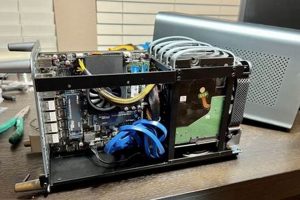A self-constructed drilling machine provides a cost-effective and customizable alternative to commercially manufactured equipment. These projects frequently involve adapting existing tools or utilizing salvaged materials to create a functional apparatus capable of precise vertical drilling. An example includes modifying a hand drill with a frame to control its movement, enabling accurate hole placement.
Constructing a drilling machine offers several advantages. Individuals can tailor the tool to specific project needs and spatial constraints, resulting in a more ergonomic and efficient workspace. Furthermore, it encourages resourcefulness and reduces reliance on mass-produced goods. Historically, the need for specialized tooling in workshops lacking capital fueled the development of inventive adaptations, often preceding the widespread availability of affordable, factory-made versions.
Subsequent sections will explore design considerations, material selection, construction techniques, and safety precautions necessary for successfully building a functional and reliable drilling apparatus. This will provide a comprehensive guide for those seeking to embark on such a project.
Essential Considerations for Self-Constructed Drilling Machines
The following guidelines promote safety, accuracy, and longevity when fabricating a drilling machine. Adherence to these suggestions can significantly improve the final product’s performance and user experience.
Tip 1: Rigidity is Paramount: Frame construction demands robust materials and secure joints. Any play or flexure in the structure directly translates to inaccuracies in drilling. Steel or heavy-gauge aluminum are recommended, joined with welding or bolted connections reinforced with gussets.
Tip 2: Ensure Accurate Alignment: Maintaining perpendicularity between the drill chuck and the work surface is critical. Employ precision measuring tools, such as squares and levels, throughout the assembly process. Shim as needed to correct for minor misalignments.
Tip 3: Implement a Reliable Feed Mechanism: The feed mechanism should provide smooth and controlled advancement of the drill bit. Consider using a lead screw or a rack and pinion system. The mechanism should also allow for adjustable depth stops to prevent over-drilling.
Tip 4: Incorporate a Stable Base: A heavy and stable base minimizes vibration and prevents the machine from tipping during operation. A cast iron base or a fabricated steel base filled with sand or concrete can effectively dampen vibrations.
Tip 5: Prioritize Electrical Safety: Ensure proper grounding of all electrical components. Use appropriately rated wiring and connections. Install a readily accessible emergency shut-off switch. Consult with a qualified electrician if unfamiliar with electrical wiring practices.
Tip 6: Use a Quality Drill Chuck: The drill chuck is the interface between the machine and the drill bit. A high-quality chuck with minimal runout is essential for accurate drilling. Consider using a keyless chuck for quick and easy bit changes.
Tip 7: Plan for Dust Extraction: Drilling creates dust and debris that can be harmful to breathe and can obscure the work piece. Integrate a dust collection port and connect it to a vacuum system to maintain a clean and safe working environment.
Following these tips during the construction process significantly increases the probability of creating a safe, accurate, and valuable drilling tool.
The next section will cover troubleshooting common issues encountered during operation of a homemade drilling apparatus.
1. Frame Rigidity
Frame rigidity constitutes a foundational element within the design and functionality of a self-constructed drilling machine. The direct correlation between the frame’s structural integrity and the machine’s operational precision is significant. Insufficient rigidity leads to unwanted vibrations and deflection under load, compromising drilling accuracy and potentially damaging the workpiece or cutting tool. For example, a frame constructed from thin-walled tubing may exhibit unacceptable flex during drilling operations, resulting in oversized or misaligned holes. A more robust frame, utilizing thicker materials and strategically placed bracing, minimizes these issues, allowing for cleaner and more accurate holes.
Beyond accuracy, frame rigidity also contributes to user safety and the longevity of the machine. Excessive vibration not only reduces drilling precision but also increases the risk of tool breakage or workpiece ejection. A solid, stable frame absorbs these vibrations, minimizing the potential for accidents. Moreover, a rigid frame reduces stress on other components, such as bearings and the motor mount, extending their lifespan and reducing the need for frequent maintenance. Consider a design incorporating welded steel or heavy-gauge aluminum. Bolted connections, when used, should be meticulously tightened and reinforced with gussets to maintain structural integrity over time.
In summary, prioritizing frame rigidity is paramount for achieving optimal performance and ensuring safety in a self-built drilling machine. Addressing this critical aspect requires careful material selection, appropriate construction techniques, and a thorough understanding of structural mechanics. While achieving perfect rigidity may be challenging, a well-engineered frame significantly enhances the overall utility and reliability of the apparatus. The consequences of neglecting frame rigidity are multifaceted, impacting accuracy, safety, and the long-term viability of the tool.
2. Alignment Accuracy
Alignment accuracy represents a critical factor in the successful fabrication and operation of a self-constructed drilling machine. Deviations from precise alignment introduce errors in hole placement and geometry, directly impacting the quality of finished workpieces and the overall functionality of the machine.
- Spindle Perpendicularity
The spindle, housing the drill chuck, must maintain a strictly perpendicular relationship to the work surface. Any angular misalignment results in holes drilled at an oblique angle, diminishing accuracy and potentially damaging the drill bit. Real-world examples include creating precisely aligned dowel holes for furniture joinery or drilling perpendicular pilot holes for threaded fasteners. Deviation from perpendicularity compromises joint strength and fastener engagement.
- Chuck Runout Minimization
Chuck runout, the measure of radial deviation as the chuck rotates, directly affects drilling precision. Excessive runout causes the drill bit to wobble, resulting in oversized or irregularly shaped holes. Employing a high-quality chuck and ensuring its proper installation on the spindle minimizes runout. Consider the consequence of excessive runout when drilling small-diam
eter holes for electronics applications, where precision is paramount. - Table Squareness
The work table must be precisely square to the drill spindle axis. Any deviation introduces angular errors in drilled holes, particularly when drilling at specific depths or when using precision measuring tools in conjunction with the drilling operation. Failure to maintain table squareness leads to inaccurate hole placement when constructing jigs or fixtures requiring precise hole positioning relative to the workpiece.
- Parallelism of Moving Components
Components allowing for vertical movement of the drilling head must maintain strict parallelism with the machine’s vertical axis. Non-parallel movement introduces lateral forces on the drill bit, leading to increased friction, premature bit wear, and potentially inaccurate hole diameters. For instance, ensure that the sliding mechanism for the drill head moves smoothly and without binding to maintain the integrity of drilled holes.
The interconnectedness of these alignment facets underscores the necessity for meticulous attention to detail during the construction phase. Compromises in alignment ripple throughout the system, degrading performance and diminishing the utility of a self-built drilling machine. Verification of alignment using precision instruments throughout the fabrication process mitigates these risks and ensures a more accurate and reliable apparatus.
3. Controlled Feed
In the context of a self-constructed drilling apparatus, a controlled feed mechanism directly impacts the accuracy, safety, and overall quality of the drilled hole. The rate at which the drill bit advances into the material is regulated by this feed. An uncontrolled or inconsistent feed leads to several undesirable consequences, including bit breakage, workpiece damage, and inaccurate hole dimensions. For instance, forcing the bit through dense hardwood without a measured feed increases friction and heat, potentially causing the bit to bind or even snap. Conversely, too slow a feed rate can cause the bit to rub against the material, work hardening it and impeding further drilling.
Implementation of a functional feed system in a homemade drilling machine requires careful consideration of mechanical design. Options range from simple lever systems providing direct manual control to more complex screw-feed mechanisms offering finer adjustments and greater precision. An example is the use of a lead screw and handwheel, allowing the user to advance the bit in small, repeatable increments. This control is particularly crucial when working with delicate materials such as thin sheet metal or brittle plastics, where even slight variations in pressure can cause deformation or cracking. Moreover, a controlled feed facilitates the creation of consistently sized holes, essential in applications requiring precise fits, such as dowel joinery or component mounting.
Ultimately, the inclusion of a well-designed and functional feed is a crucial component in any self-constructed drilling machine. It elevates the tool from a rudimentary drilling device to a precision instrument capable of producing accurate and repeatable results. Without controlled feed, the benefits of a rigid frame and accurate alignment are substantially diminished. Prioritizing the integration of a reliable feed mechanism ensures the practical utility and overall effectiveness of the project.
4. Stable Base
A stable base constitutes a fundamental requirement for any functional drilling apparatus, particularly within the context of self-constructed models. It provides the necessary foundation to minimize vibration and ensure accurate drilling, directly influencing the machine’s performance and the safety of its operation.
- Vibration Dampening
The primary role of a stable base is to dampen vibrations generated during the drilling process. These vibrations, if unchecked, propagate through the entire structure, leading to inaccuracies in hole placement and increased tool wear. For instance, when drilling through dense materials, the cutting forces induce significant vibration. A heavy base, constructed from materials like cast iron or reinforced concrete, effectively absorbs these vibrations, improving drilling precision. Failure to provide adequate vibration dampening results in chatter marks on the workpiece and premature drill bit dulling.
- Prevention of Tipping
A stable base also prevents the drilling machine from tipping over during operation. The forces exerted by the drilling process, particularly when encountering resistance or using larger drill bits, can generate substantial torque. A wide and heavy base provides a low center of gravity, resisting these forces and ensuring stability. Consider a situation where drilling a large-diameter hole near the edge of a workpiece. Without a sufficiently stable base, the machine may become unstable, posing a safety hazard to the operator and potentially damaging the workpiece.
- Workpiece Support
The base often incorporates a work surface or table that supports the workpiece being drilled. This table must be rigid and level to ensure accurate hole placement. A stable base contributes to the overall rigidity of the support structure, preventing deflection under load. For example, when drilling a long, thin piece of material, a stable base and work table provide consistent support along its length, minimizing bending or warping that could affect drilling accuracy. An unstable work surface can lead to inconsistent hole depths and angles.
- Enhanced Control and Precision
By minimizing movement and vibration, a stable base allows for greater control and precision during drilling operations. The operator can focus on guiding the drill bit accurately without contending with instability or excessive vibration. The result is cleaner, more accurate holes and reduced operator fatigue. An unstable base can also lead to inconsistent results, making it difficult to achieve the desired level of precision, particularly in tasks demanding tight tolerances.
The importance of a stable base in a self-constructed drilling machine cannot be overstated. It directly impacts the tool’s accuracy, safety, and longevity. The selection of materials and the design of the base are critical considerations in the construction process, with heavier and wider bases generally offering superior performance. Investing in a robust and stable base significantly enhances the overall utility and reliability of a shop-built drilling apparatus.
5. Chuck Quality
The chuck, a critical component of any drilling machine, assumes particular importance in self-constructed variations. It directly affects drilling accuracy, bit retention, and overall operational safety. Selection of an appropriate chuck, therefore, warrants careful consideration during the construction of a drilling apparatus.
- Runout and Precision
Chuck runout, defined as the degree of radial deviation of the drill bit during rotation, significantly impacts hole accuracy. Higher quality chucks exhibit minimal runout, ensuring that the drilled
hole closely matches the intended diameter. In contrast, excessive runout leads to oversized holes, increased bit wear, and potential workpiece damage. For precision tasks, such as creating closely fitted joints or drilling pilot holes for threading, a chuck with minimal runout is indispensable. Conversely, a low-quality chuck may compromise accuracy, rendering the drilling apparatus unsuitable for tasks demanding tight tolerances. - Grip Strength and Bit Retention
The chuck’s ability to securely grip and retain the drill bit is crucial for safe and efficient operation. Insufficient grip strength results in bit slippage, leading to inaccurate drilling and potential damage to the workpiece or drill bit. A robust chuck design, employing hardened jaws and a reliable tightening mechanism, ensures that the bit remains firmly secured throughout the drilling process. Bit slippage is particularly problematic when drilling hard materials or using large-diameter bits, where significant torque is generated. Prioritizing chucks with high grip strength minimizes the risk of bit slippage and enhances operational safety.
- Chuck Type and Application
Various chuck types, including keyed and keyless designs, offer different advantages and disadvantages. Keyed chucks provide a secure grip but require a separate key for tightening and loosening. Keyless chucks offer convenient bit changes without the need for a key, but their grip strength may be less secure than keyed chucks, particularly under heavy loads. The selection of chuck type should align with the intended applications of the drilling apparatus. Keyed chucks may be preferable for heavy-duty drilling tasks, while keyless chucks offer greater convenience for frequent bit changes.
- Durability and Longevity
A high-quality chuck, constructed from durable materials and engineered for long-term use, contributes to the overall reliability and lifespan of the drilling apparatus. Chucks subjected to frequent use and heavy loads are prone to wear and tear, potentially compromising their grip strength and accuracy. Selecting a chuck from a reputable manufacturer, known for producing durable and reliable products, is essential for ensuring long-term performance and minimizing the need for replacements. A durable chuck withstands the rigors of frequent use and maintains its accuracy over time, enhancing the overall value of the self-constructed drilling machine.
The relationship between chuck quality and the effectiveness of a self-constructed drilling press is therefore direct and significant. Investing in a quality chuck is an investment in the accuracy, safety, and longevity of the entire tool.
DIY Drill Press
This section addresses common inquiries regarding the construction and utilization of self-built drilling machines. The information provided aims to clarify prevalent concerns and misconceptions associated with this type of project.
Question 1: What is the minimum recommended motor horsepower for a functional drilling machine?
The appropriate motor horsepower depends upon the anticipated drilling tasks and materials. For light-duty work, such as drilling small holes in soft materials, a 1/4 horsepower motor may suffice. However, for drilling larger holes in harder materials, a 1/2 to 3/4 horsepower motor is recommended to provide adequate torque and prevent stalling.
Question 2: How critical is the use of bearings in the spindle assembly?
The implementation of quality bearings within the spindle assembly is of paramount importance. Bearings minimize friction, reduce runout, and contribute to smooth and accurate drilling. The absence of bearings, or the use of low-quality bearings, leads to increased wear, vibration, and diminished precision. Sealed bearings are preferred to prevent contamination and extend bearing life.
Question 3: Is it possible to adapt an existing hand drill for use in a self-constructed drilling machine?
Adapting a hand drill for use in a self-constructed drilling machine is a common and viable approach. However, it is crucial to ensure that the hand drill is securely mounted and that the frame provides adequate support and rigidity. Consider the hand drill’s speed range and torque output to determine its suitability for the intended drilling tasks. Furthermore, carefully evaluate the hand drill’s on/off switch mechanism for ease of integration with the drilling machine’s control system.
Question 4: What safety precautions should be observed during the operation of a self-built drilling machine?
Prioritizing safety is essential when operating a self-built drilling machine. Always wear appropriate eye protection to guard against flying debris. Securely clamp the workpiece to prevent movement during drilling. Avoid wearing loose clothing or jewelry that could become entangled in the rotating drill bit. Disconnect the power source before making any adjustments or repairs. Furthermore, never leave the machine unattended while it is running.
Question 5: How does one ensure accurate alignment between the drill bit and the workpiece?
Achieving accurate alignment requires meticulous attention to detail during the construction process. Utilize precision measuring tools, such as squares and levels, to ensure that the drill spindle is perpendicular to the work surface. Shim the machine base as needed to compensate for any irregularities in the supporting surface. Regularly check the alignment using a machinist’s square to maintain accuracy over time.
Question 6: What are the common causes of excessive vibration in a self-built drilling machine, and how can they be addressed?
Excessive vibration typically results from inadequate frame rigidity, unbalanced rotating components, or loose connections. Ensure that the frame is constructed from robust materials and that all joints are securely fastened. Balance the drill chuck and spindle assembly to minimize vibration caused by rotational imbalances. Inspect all bolts, screws, and other fasteners regularly and tighten them as needed.
In summary, careful planning, precise construction, and adherence to safety guidelines are essential for creating a functional and reliable self-built drilling machine. Addressing these FAQs proactively can mitigate potential challenges and enhance the overall success of the project.
The subsequent section will explore the economic considerations involved in building versus buying a drilling machine.
DIY Drill Press
This exploration has detailed critical aspects of self-constructed drilling machines, from frame rigidity and alignment accuracy to the implementation of controlled feed mechanisms and stable bases. The importance of selecting a quality chuck and adhering to stringent safety protocols has been underscored. Addressing frequently asked questions regarding motor horsepower, spindle bearings, hand drill adaptation, and vibration mitigation provided further insight into the intricacies of such projects.
The decision to fabricate a diy drill press demands a realistic assessment of skills, resources, and project requirements. While the potential for cost savings and customization exists, the endeavor necessitates a commitment to precision and safety. Careful consideration of these factors is paramount to ensuring a successful outcome and a valuable addition to the workshop.







